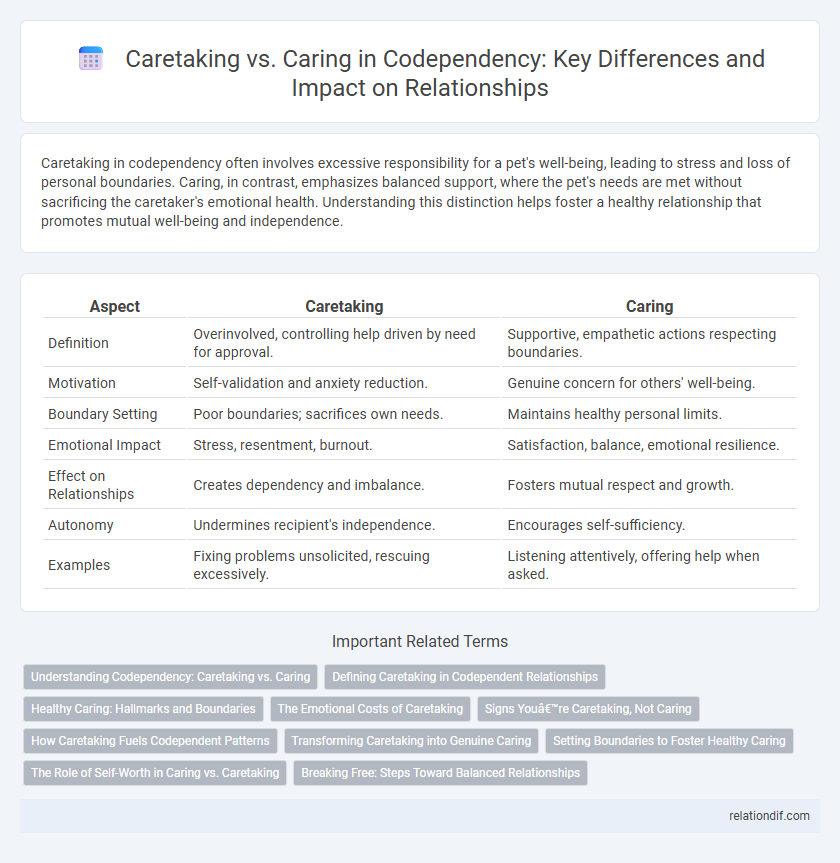Caretaking in codependency often involves excessive responsibility for a pet's well-being, leading to stress and loss of personal boundaries. Caring, in contrast, emphasizes balanced support, where the pet's needs are met without sacrificing the caretaker's emotional health. Understanding this distinction helps foster a healthy relationship that promotes mutual well-being and independence.
Table of Comparison
| Aspect | Caretaking | Caring |
|---|---|---|
| Definition | Overinvolved, controlling help driven by need for approval. | Supportive, empathetic actions respecting boundaries. |
| Motivation | Self-validation and anxiety reduction. | Genuine concern for others' well-being. |
| Boundary Setting | Poor boundaries; sacrifices own needs. | Maintains healthy personal limits. |
| Emotional Impact | Stress, resentment, burnout. | Satisfaction, balance, emotional resilience. |
| Effect on Relationships | Creates dependency and imbalance. | Fosters mutual respect and growth. |
| Autonomy | Undermines recipient's independence. | Encourages self-sufficiency. |
| Examples | Fixing problems unsolicited, rescuing excessively. | Listening attentively, offering help when asked. |
Understanding Codependency: Caretaking vs. Caring
Caretaking in codependency often involves sacrificing personal needs to control or fix others, leading to unhealthy boundaries and emotional exhaustion. Caring, by contrast, maintains healthy boundaries, promotes mutual respect, and supports others without losing self-identity. Understanding these differences is crucial for fostering balanced relationships and breaking codependent patterns.
Defining Caretaking in Codependent Relationships
Caretaking in codependent relationships involves excessive and compulsive efforts to manage others' problems, emotions, or needs at the expense of one's own well-being. This behavior often stems from a deep-seated fear of abandonment or rejection, leading individuals to prioritize others' validation over healthy boundaries. Unlike caring, which is balanced and reciprocal, caretaking perpetuates dependency and emotional exhaustion within the relationship.
Healthy Caring: Hallmarks and Boundaries
Healthy caring involves providing support and empathy without sacrificing personal well-being or autonomy, distinguishing it from caretaking that can foster dependency. Key hallmarks include clear boundaries, mutual respect, and emotional self-regulation to prevent enabling or resentment. Establishing limits on time, energy, and emotional investment preserves balanced relationships and promotes individual growth.
The Emotional Costs of Caretaking
Caretaking in codependency often involves excessive emotional investment that leads to burnout, anxiety, and loss of personal identity. Unlike healthy caring, caretaking prioritizes another's needs at the expense of one's own emotional well-being, resulting in chronic stress and resentment. This imbalance disrupts emotional boundaries, causing long-term psychological distress and eroding self-esteem.
Signs You’re Caretaking, Not Caring
Signs you're caretaking rather than truly caring include feeling responsible for others' emotions and problems, often leading to neglect of your own needs. You may experience exhaustion, resentment, or anxiety when unable to control outcomes or fix situations. True caring respects boundaries and encourages independence, while caretaking blurs limits and fosters dependency.
How Caretaking Fuels Codependent Patterns
Caretaking often involves assuming responsibility for others' emotions and problems, which can entrench codependent patterns by blurring boundaries and fostering unhealthy reliance. This dynamic promotes neglect of personal needs and reinforces a cycle where self-worth is tied to others' approval or dependence. Recognizing the difference between genuine caring and controlling caretaking is critical to breaking free from codependency.
Transforming Caretaking into Genuine Caring
Transforming caretaking into genuine caring requires shifting from controlling behaviors to empathy-driven support, prioritizing mutual respect and healthy boundaries. Caretaking often reinforces codependency by enabling dependency, while authentic caring fosters autonomy and emotional growth in both individuals. Developing self-awareness and practicing open communication are crucial steps to nurture sincere, balanced relationships rooted in care rather than obligation.
Setting Boundaries to Foster Healthy Caring
Setting clear boundaries distinguishes healthy caring from caretaking by ensuring personal needs are respected while supporting others. Maintaining limits prevents emotional burnout and promotes balanced relationships where both parties feel valued and empowered. Effective boundary-setting cultivates mutual respect and fosters sustainable, compassionate connections without enabling dependency.
The Role of Self-Worth in Caring vs. Caretaking
Caretaking often stems from low self-worth, where individuals sacrifice their own needs to gain approval or avoid rejection, leading to unhealthy dependencies. In contrast, genuine caring is rooted in healthy self-esteem, allowing individuals to support others without losing their own identity or boundaries. Understanding the role of self-worth is crucial for distinguishing between nurturing relationships and enabling codependent behaviors.
Breaking Free: Steps Toward Balanced Relationships
Breaking free from codependency starts with distinguishing caretaking from genuine caring by setting healthy boundaries that protect personal well-being while supporting others. Effective steps include practicing self-awareness to identify enabling behaviors, fostering open communication to express needs, and prioritizing self-care to maintain emotional balance. Establishing these patterns cultivates balanced relationships rooted in mutual respect and independence rather than control and obligation.
Caretaking vs Caring Infographic

 relationdif.com
relationdif.com